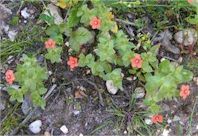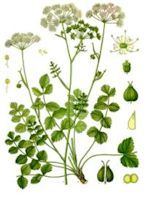|

Scarlet Pimpernel |
The "Poor Man's Weather Glass" or "Shepherd's Dial," is a very well-known and favorite little flower, of brilliant scarlet hue, expanding only in bright weather, and closing its petals at two o'clock in the day. It occurs quite commonly in gardens and open fields, being the scarlet Pimpernel, or Anagallis arvensis, and belonging to the Primrose tribe of plants. Old authors called it Burnet; which is quite a distinct herb, cultivated now for kitchen use, the
Pimpinella Saxifraga, of so cheery and exhilarating a quality, and so generally commended, that its excellence has passed into a |
proverb, "l'insolata non buon, ne betta ove non ?Pimpinella." But this Burnet Pimpinella is of a different (Umbelliferous) order, though similarly styled because its leaves are likewise bipennate.
The Scarlet Pimpernel is named "Anagallis", from the Greek anagelao, to laugh; either because, as Pliny says, the plant removes obstructions of the liver, and spleen, which would engender sadness, or because of the graceful beauty of its flowers:
"No ear hath heard, no tongue can tell
The virtues of the Pimpernell."
The little plant has no odor, but possesses a bitter taste, which is rather astringent. Doctors used to consider the herb remedial in melancholy, and in the allied forms of mental disease, the decoction, or a tincture being employed. It was also prescribed for hydrophobia, and linen cloths saturated with a decoction were kept applied to the bitten part.
Narcotic effects were certainly produced in animals by giving considerable doses of an extract made from the herb. The flowers have been found useful in epilepsy, twenty grains dried being given four times a day. A medicinal tincture (H.) is prepared with spirit of wine. It is of approved utility for irritability of the main urinary passage, with genital congestion, erotism, and dragging of the loins, this tincture being then ordered of the third decimal strength, in doses of
from five to ten drops every three or four hours, with a spoonful of water.
A decoction of the plant is held in esteem by country folk as checking pulmonary consumption in its early stages. Hill says there are many authenticated cases of this dire disease being absolutely cured by the herb. The infusion is best made by pouring boiling water on the fresh plant. It contains "saponin," such as the Soapwort also specially furnishes.
In France the Pimpernel (Anagallis) is thought to be a noxious plant of drastic narcotico-acrid properties, and called Mouron--qui tue les petits oiseaux, et est un violent drastique pour l'homme, et les grands animaux; ?ose tres elev?le mouron peut meme leur donner la mort. In California a fluid extract of the herb is given for rheumatism, in doses of one teaspoonful with water three times a day.
|

Burnet Pimpinella |
The "Burnet Pimpinella" is more correctly the Burnet Saxifrage, getting its first name because the leaves are brown, and the second because supposed to break up stone in the bladder. It grows abundantly in our dry chalky pastures, bearing terminal umbels of white flowers. It contains an essential oil and a bitter resin, which are useful as warmly carminative to relieve flatulent indigestion, and to
promote the monthly flow in women. An infusion of the herb is made, and given in two tablespoonfuls for a dose. Cows which feed on this plant have their flow of milk increased thereby. Small bunches of the leaves and shoots when tied together and suspended in a cask of beer impart to it an agreeable aromatic flavor, and are thought to correct tart, or spoiled wines. The root, when fresh, has a hot pungent bitterish taste,
and may be usefully chewed for tooth-ache, or to obviate paralysis |
of the tongue. In Germany a variety of this Burnet yields a blue essential oil which is used for coloring brandy. Again the herb is allied to the Anise (Pimpinella Anisum). The term Burnet was formerly applied to a brown cloth. Smaller than this Common Burnet is the Salad Burnet, Poterium sanguisorba, quod sanguineos fluxus sistat, a useful styptic, which is also cordial, and promotes perspiration. It has the smell of cucumber, and is, therefore, an ingredient of the
salad bowl, or often put into a cool tankard, whereto, says Gerard, "it gives a grace in the drynkynge." Another larger sort of the Burnet Pimpinella (Magna), which has broad upper leaves less divided, grows in our woods and shady places.
A bright blue variety of the true Scarlet Pimpernel (Anagallis) is less frequent, and is thought by many to be a distinct species. Gerard says, "the Pimpernel with the blue flower helpeth the fundament that is fallen down: and, contrariwise, red Pimpernel being applied bringeth it down."
|

Water Pimpernel |
The Water Pimpernel (Anagallis aquatica) is more commonly known as Brooklime, or Beccabunga, and belongs to a different order of plants, the Scrophulariaceoe (healers of scrofula).
It grows quite commonly in brooks and ditches, as a succulent plant with smooth leaves, and small flowers of bright blue, being found in situations favorable to the growth of the watercress. It is the brok lempe of old writers, Veronica beccabunga, the syllable bec signifying a beck or brook; |
or perhaps the whole title comes from the Flemish beck pungen, mouth-smart, in allusion to the pungent taste of the plant.
"It is eaten," says Gerard, "in salads, as watercresses are, and is good against that malum of such as dwell near the German seas, which we term the scurvie, or skirby, being used after the same manner that watercress and scurvy-grass is used, yet is it not of so great operation and virtue." The leaves and stem are slightly acid and astringent, with a somewhat bitter taste, and frequently the former are mixed by sellers of water-cresses with their stock-in-trade.
A full dose of the juice of fresh Brooklime is an easy purge; and the plant has always been a popular Simple for scrofulous affections, especially of the skin. Chemically, this Water Pimpernel contains some tannin, and a special bitter principle; whilst, in common with most of the Cruciferous plants, it is endowed with a pungent volatile oil, and some sulphur. The bruised plant has been applied externally for healing ulcers, burns, whitlows, and for the mitigation of swollen
piles.
The Bog Pimpernel (Anagallis tenella), is common in boggy ground, having erect rose-colored leaves larger than those of the Poor Man's Weather Glass.
Herb Simples
The Primitive Simplers presented here show the way of life in other generations, it is not suggested or recommended trying them yourself. |
|
Garden
Herbs
Home
History of Herbs
Herb Gardening
Herbs for Beginners
Drying & Preserving Herbs
Indoor Herb Gardening
Herb Garden
Hints & Tips
Herbal
Cooking
Herb Chart
Using Herbs
Culinary Herbs
Herb
Oil and Vinegar
Herb Teas
Herb Candy
Herb Jelly
Herb Simples
Preface
Introduction
Alphabetical Listing

Trade
Recipes Online
Share your Recipes with others!!
|




